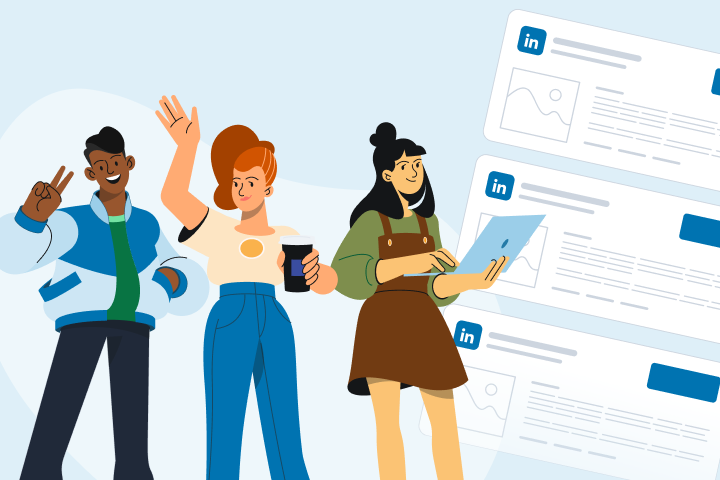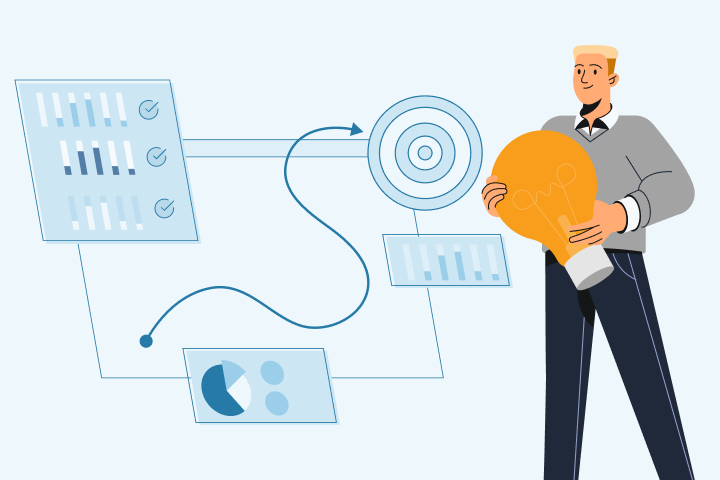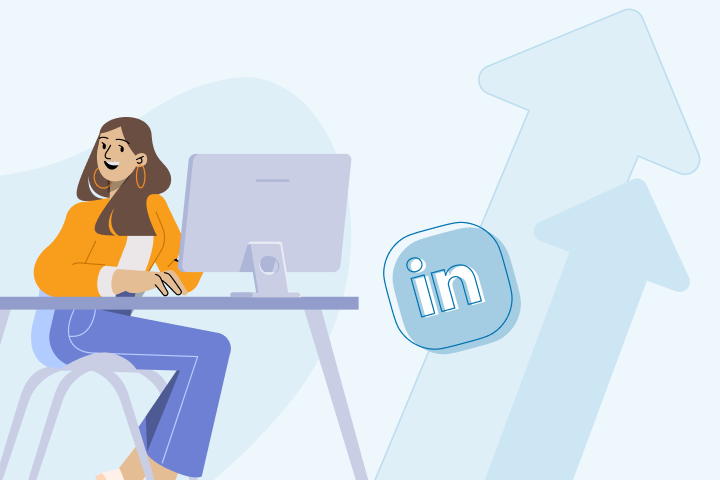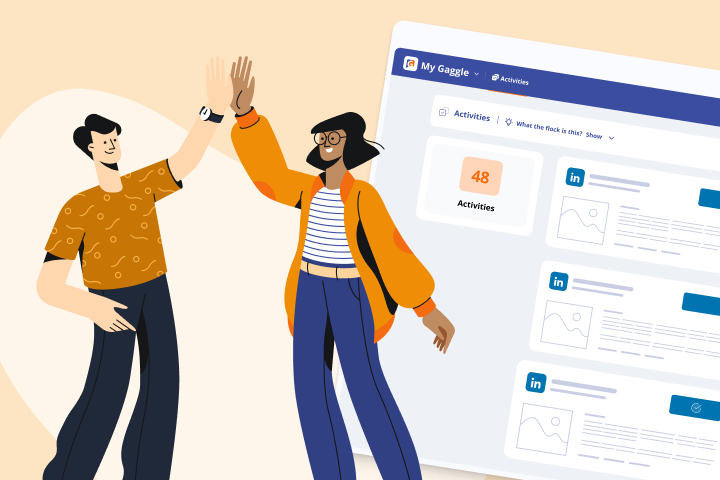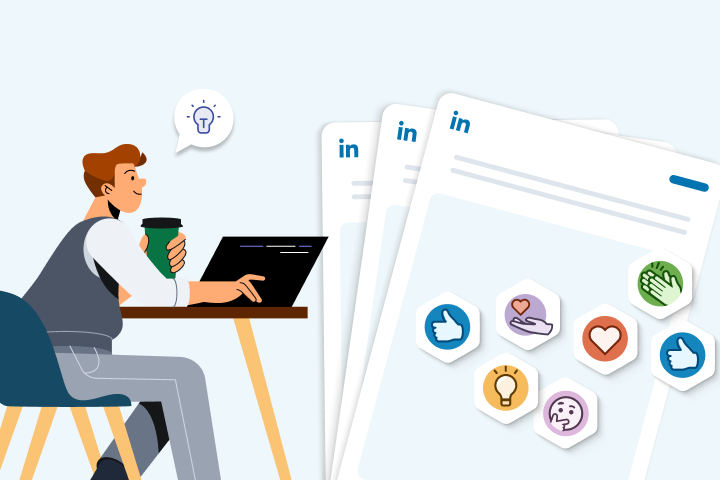The Ultimate Guide to Brand Awareness With Employee Advocacy
Ever noticed how certain LinkedIn posts just pop? Consistent styling, familiar faces, on-theme messaging — that's brand awareness at play.
It's the Baader-Meinhof Phenomenon: you spot a thing once, suddenly, it's everywhere. But, it's not actually multiplying — you're simply more tuned in to it. Ready to dial up your brand so your audience notices it when they see your social media posts?
Keep reading for actionable brand awareness strategies, immediate tips, and real-world examples to help you boost your brand awareness. Plus, we're highlighting tools to morph your team into your brand's strongest social media influencers.
Understanding Brand Awareness
As a quick review, brand awareness measures how well consumers know a company, particularly its products or services. The stronger your brand awareness, the bigger your edge over your competition because consumers gravitate towards what they know and trust.
Think of brand awareness as a scale. On one end, you have folks who might just recognize your company name. On the other end, you've got the super fans who know what you sell, what you stand for, and what sets you apart from the rest.
For example, ClickUp’s name is synonymous with productivity. They've created a one-stop-shop where teams can do everything from brainstorming to planning and collaborating. Plus, Clickup uses relatability and a good dose of humor to promote its SaaS.

Source: ClickUp
ClickUp has surpassed brand recognition and achieved brand awareness. Often, brand awareness and brand recognition are used interchangeably, but here’s the difference:
-
Brand Awareness is consumers’ familiarity with your brand’s image, logo, and products. and what you offer. You can gauge it by how quickly they recall your brand or if it's the first one they think of in your industry.
-
Brand Recognition is one step further, when the brand identity and the product sold become synonymous. For example, you ask for a Kleenex in lieu of a tissue, or you ask someone if they Googled that.
To grow brand awareness and customer trust, you can boost your brand awareness through various channels like advertising, social media, content marketing, PR, and strategic partnerships.
Benefits of Brand Awareness
When you think of “productivity apps,” companies like ClickUp and Notion probably jump to mind, right? Their branding, voice, and content are consistent. ClickUp is a vibrant color party, while Notion keeps it simple with black, white, and hand-drawn illustrations. But, brand awareness isn't just about the look and feel of your marketing.
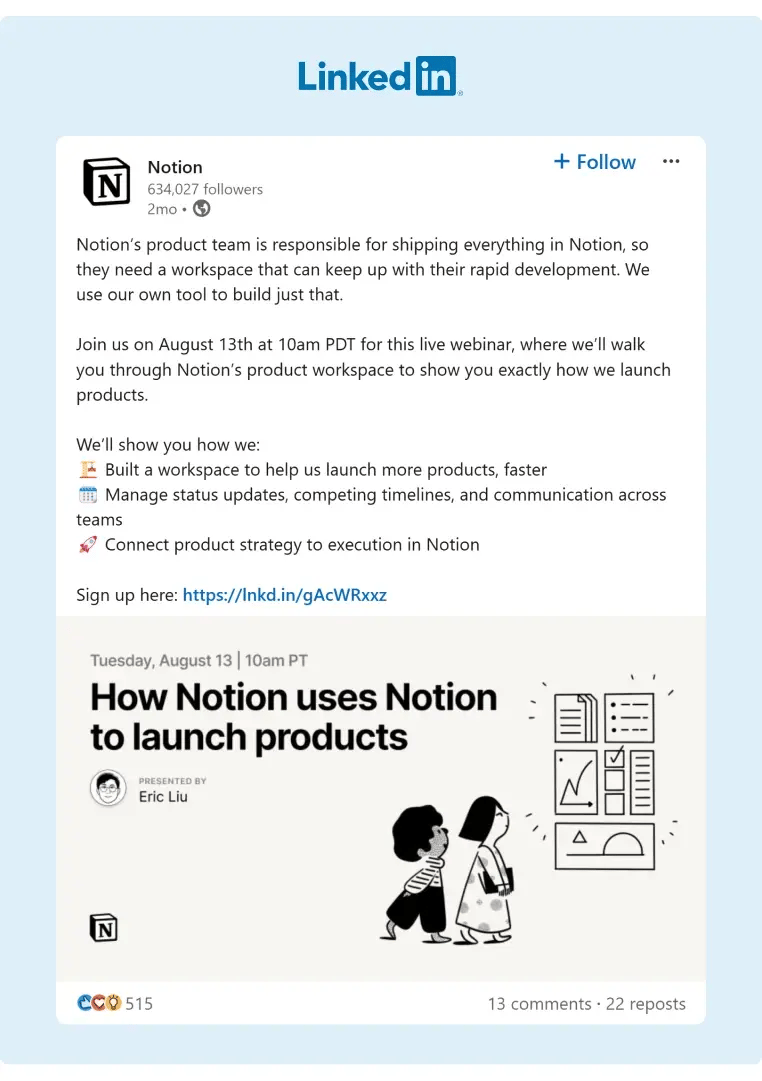
Source: Notion
Measuring the ROI of brand awareness can feel like trying to catch a fish with your bare hands. The folks in your C-suite want hard numbers, and brand awareness seems a fuzzy concept. But, you can highlight these measurable benefits to convince your leadership:
-
Humanizes Your Brand: Use storytelling and authentic communication to build connections. A strong reputation boosts sales, fosters long-term relationships, and attracts top talent.
-
Builds Trust and Credibility: A lot of the sales process is trust-building, so having a head start reduces the sales cycle and saves time and remarketing costs.
-
Increases Company Value and Longevity: A strong brand is a stable brand, and brand awareness can increase your company's value and make it more recession-proof.
How To Increase Brand Awareness
You’re probably here because of these solid benefits. Like those companies, you want to boost your brand awareness, too. Here’s where to start:
Step 1: Set Measurable Goals
First, narrow down the goals you’re aiming for:
-
Is it more website traffic?
-
A larger audience?
-
A spike in company name searches?
Once you know your goals, decide which key performance indicators (KPIs) you’ll track. You can also mix and match the KPIs that align with your business goals. Those KPIs are the yardstick you use to measure your brand awareness campaign’s success.
Keep in mind your brand awareness strategy needs to sync with your broader marketing goals and strategies. A mismatch in brand messaging can throw a wrench in your marketing efforts.
Step 2: Explore LinkedIn as a B2B Marketing Channel
Instead of spreading yourself too thin across all social platforms, prioritize the channels that matter to your audience. If you’re in B2B, there’s a good chance that platform is LinkedIn. As the saying goes, meet them where they are. That might be why folks, like RB2B CEO Adam Robinson, zero in on LinkedIn as their social media platform of choice.

Source: RB2B
That’s also the place to be if you want your employees to advocate for your company. Employees are less likely to post on Facebook or X, which tend to be personal spaces. LinkedIn, with its business-focused vibe, is where they gather.
Our research backs this up — people flock to LinkedIn for business communication and networking. We’ve found that over 70.16% of activities created on GaggleAMP are now for LinkedIn, with just 13.12% for X. So, adjust your strategy to where your audience is most active to stay in the game.
Step 3: Follow a Consistent Publishing Workflow
One of the secrets to boosting brand awareness on LinkedIn is sticking to a repeatable format and publishing regularly, as Exit Five does. Captions for each podcast video snippet shared have a standard format: hook, teaser, podcast agenda, and CTA, making them easy to spot in a busy feed. Plus, podcast guests cross-promote on their feeds, which gets even more eyes on Exit Five’s content.

Source: Exit Five
Consistency like this is key for a couple of reasons:
-
Audiences Love Familiar Formats: When someone subscribes to your channel, they're saying “yes” to your content style and ideas. Change it, and you risk losing them. Instead, stay consistent and give your subscribers what they signed up for.
-
You Can Set Up Standard Operating Procedures (SOPs): Constantly changing formats makes it harder to scale. If you change it, they’ll have to relearn the workflow. You might think that it’s just faster to do it yourself. But, when you can't assign specific tasks to your team, it hampers content production and prevents them from becoming experts in any format.
So, how do you choose a format? Look at what’s working for your competitors and use that to inspire your strategy.
Once you've nailed down a format, create SOPs and assign specific tasks to everyone on your team. This way, your publishing schedule will stay on track and allow you to ramp up your publishing frequency gradually. To streamline your workflow, manage your SOPs with tools like Trello, Notion, and ClickUp. A project management hub makes it easy for your team to find what they need to get the job done.
Step 4: Tap Into the Power of Employee Advocacy
Many of your employees have connections who could benefit from your products or services. You can boost brand awareness by asking employees to share company messages on social media.
Take Semrush, for instance. When Semrush posted its Q2 results, its brand page wasn’t the only place to find it. Employees like Semrush CMO Andrew Warden also shared those results on their LinkedIn pages. Employee advocacy expands your marketing reach into your employees' networks and their networks.

Source: Andrew Warden
And, the best part of employee advocacy? It's cost-effective. Unlike influencer marketing, you don't have to pay employees for each engagement (although offering some incentives never hurts).
The tricky bit with employee advocacy? Keeping employees engaged over the long haul.
Employees often start enthusiastically hyping up the brand, but their engagement may decline over time. Either they don't have time to participate, don’t know what to post, or are worried about saying something off-brand.
Here's the fix: Using an employee advocacy tool like GaggleAMP lets you assign specific engagement activities to employees at scale, but you’ll learn about that in more depth later.
Want to try it — now? Sign up for your GaggleAMP trial today.
Step 5: Collaborate With Influencers
As Capsule's Head of Marketing Natalie Taylor puts it, influencer marketing campaigns can be incredibly effective. You pay a one-time fee or strike up a mutually beneficial collaboration to access your target audience through someone they trust.

Source: Natalie Taylor
For instance, if you run a newsletter, partner with an industry influencer or a parallel brand. You promote their content to your audience, and they do the same for you.
You could also ask an influencer to share your latest content in a LinkedIn post. In return, you can share one of their pieces on your brand's LinkedIn page. Or even have an executive share it from their profile.
Another option is collaborating on content, like a podcast or an interview-style blog post. Influencers are usually more than happy to share collaborative content with their followers since they've also invested time and effort into creating it.
Step 6: Engage With Your Community
Good old-fashioned engagement with your audience is one of the best ways to build brand awareness. You're depositing into your audience relationship bank account by taking every opportunity to comment on others’ posts (companies or individuals) or interact with folks who took the time to comment on your posts.
Need a great way to initiate engagement? Ask questions. (See what we did there?) In this example, Semrush asks a fun question that creative (and possibly bored) LinkedIn scrollers are excited to interact with. Then, Semrush responds to each reply to keep the conversation flowing.

Source: Semrush
You can also join active LinkedIn groups and answer posters’ questions. Interacting and providing value builds goodwill within the community and makes people more likely to reciprocate by supporting your content.
Power Moves To Boost Brand Awareness
A thriving brand awareness strategy is attention-grabbing, memorable, and fosters dialogue. Check out these tips for creating your own.
Keep Communication Open
When it comes to clinching and retaining customers, the secret is giving them a voice. Take a cue from RB2B and use your LinkedIn post space to gather opinions straight from the folks you need to hear from the most. That’s not the only benefit. Customers feel a sense of ownership when they have a say in a product or service offering.

Source: RB2B
Another way to boost communication is by tossing quick and easy prompts to your audience. These digital icebreakers are a fun way to get them to interact with you regularly. And, when they do, make sure you respond. It shows your audience that you're not just broadcasting but genuinely engaging with them.

Source: ClickUp
Want to earn your customers’ goodwill? Don’t forget to celebrate your customers. That’s what ClickUp does. A little recognition goes a long way, whether it's a shout-out or a highlight of their successes related to your product or service.

Source: ClickUp
Attract Attention
With content, there’s a three-pronged approach: educating, entertaining, and persuading. You want to avoid the trap of only posting one type of content.
Offering a variety of content increases your chances of connecting with your target audience. Let's explore what other companies have done with their content to grab attention:
Invite Conflict
RB2B isn’t afraid to bring a hot take or address a conflict with another company. Some might argue that if your content tries to please everyone, it ends up saying nothing.
Whether you agree or not, bringing drama and controversy attracts a ton of attention to your content.

Source: Adam Robinson
Use Humor
To lighten the mood, Exit Five CEO Dave Gerhardt often posts from his personal LinkedIn account. The post sprinkles humor with a behind-the-scenes look that reminds its audience that even the thought leaders of a company are human. They don't always have it all together.

Source: Dave Gerhardt
When you don’t take yourself too seriously, and use humor when appropriate, it humanizes your brand and makes your content more relatable.
Flex Your Creative Muscle
Off-the-wall content like Duo the Duolingo owl and ClickUp's creative HR video series show that people crave creativity and novelty. Note this post’s 1,241 engagements in only four days.

Source: ClickUp
What’s the appeal? The ClickUp post offers a hyperbolic yet relatable take on corporate culture. You'll grab attention and hook your audience by creating something that no one else is doing.
Add Value With Helpful Tips
If you’re one to scroll through your LinkedIn feed, hoping that something — anything — makes it worth your time, you understand this tip. Semrush adds value by listening to customers and serving up a heaping helping of actionable takeaways, and all wrapped up in a tidy infographic.

Source: Semrush
By providing well-organized, visually appealing content that suggests tools to streamline marketing and boost success, Semrush is not just attracting attention — it’s providing tangible value, and, so can you.
Want your employees to use content you create to wow their networks? Start a GaggleAMP trial today.
Produce Quality Content Consistently
As with vitamins and leg days at the gym, consistency is essential to keeping LinkedIn's algorithm and your audience engaged. Whether you're sharing product updates like ClickUp, thought leadership pieces, or product updates, regular posting gets results.

Source: ClickUp
While daily posts are ideal, focus more on maintaining a steady rhythm of posting instead of a continuous one. If you feel overwhelmed with regular posting, schedule posts in advance using a social media tool. But, be ready to adjust your schedule in response to current industry events or brand mentions.
If dreaming up posts is a challenge, consider repurposing your content if you’re not already. You can generate a few social media posts from a single blog post, podcast, webinar, and the like.
If you’re concerned about annoying your audience with repetitive posts, don't stress. Only a fraction of your followers see each post. Given the vast amount of content they encounter daily, there's a good chance they've forgotten your previous post. So, don't hold back from repurposing and reposting.
Try GaggleAMP for free to see how it improves your social media engagement, or schedule a demo with our team.
Listen to and Interact With Your Audience
Look at engaging with your audience as a conversation. Like with ClickUp, when you respond to comments on your posts, two things happen:
-
People are more likely to engage with your posts because it feels like a dialogue.
-
LinkedIn's algorithm notices the increased engagement and rewards your post with more visibility.

Source: ClickUp
To get the most from each comment's potential, respond with a question or a thoughtful remark rather than a simple "thank you" or a "yes/no." Engaging responses encourage further conversation, driving up the comment count and ultimately giving your post a bigger boost in the algorithm. Plus, if your audience knows that you actively respond to comments, they're more likely to engage with your future posts.
Drive Brand Awareness With GaggleAMP’s Employee Advocacy Tools
Messler nailed the art of boosting brand awareness with her post about Exit Five’s new Member Matchmaking Program. What message does it send to folks in the Exit Five sphere? "We heard you, and we made this for you."

Source: Danielle Messler
That's the power of human connection in employee advocacy. That’s why we created an employee advocacy platform to make marketing easier for you.
GaggleAMP boosts engagement and reach for your brand and employees. Besides turning your employees into micro-influencers, here are other GaggleAMP stats to celebrate:
-
Gaggles generate an average of 777 activities per year, or around 15 activities per week for members to share.
-
Nearly 10,000 activities are completed by Gaggle members in each Gaggle.
-
These Gaggles reach over 23.2 million people every year.
-
Gaggles add about 11,000 social interactions and 3,500 clicks per year.
-
$61,718 is the average employed earned media value associated with the average Gaggle each year.
In fact, that average EEMV is more than the costs of investing in an employee advocacy program. Running an employee advocacy program is like using influencer marketing, but it’s more cost-effective because your influencers are your employees.
Boosting engagement on LinkedIn posts might seem as simple as getting other employees to interact. Yet, running a successful employee advocacy program has its challenges like these two:
-
Managers often individually email coworkers request engagement each time a post goes live, which is a time-suck and lacks engagement tracking.
-
Posting a blanket request for employee engagement on a Slack channel often fails because the request isn’t personalized, so employees don’t feel accountable.
GaggleAMP Takes the Challenge Out of Encouraging Employee Advocacy
Here’s how GaggleAMP works. You transform employees into brand advocates by assigning an engagement activity to specific employees. These employees receive a notification that there’s an activity, making it convenient for them to schedule their new posts or engage with content for the week.
[IMAGE: Product Screenshot or Video]
What Are the Manager and Member Dynamics in GaggleAMP?
Worried an employee can go rogue and assign engagements you don’t want plastered all over LinkedIn or other platforms? Concerned certain messages in engagements won’t make sense in a cultural context? GaggleAMP alleviates those concerns through specific roles.
In GaggleAMP, a Manager is always a Member (employee), but a Member isn't always a Manager. Managers assign activities from their portal, create Member groups, and choose activity recipients, and Members have permissions only to receive and perform the activities assigned to them. The ability to pick and choose who gets a specific message is a boon for distributed teams with diverse backgrounds.
What Does the Member Do When Assigned an Engagement?
GaggleAMP makes it easy for Members to engage with content created just for them while not distracting them from their day-to-day activities. One of those reasons is because it’s so easy to navigate.

Members view activities in their "Things to Do" list in the side column. With one click, Members can publish company content in their LinkedIn posts to amplify reach and engagement with their social audience. They can also add their perspective to personalize it for their audience. If they want to opt-out, they simply click "No Thanks."
Friendly Competition With GaggleAMP's Leaderboard
Want to give your Members a little nudge to post? Encourage employee advocacy with GaggleAMP's Leaderboard. It shows the most engaged employees, stimulating friendly competition through gamification.
Some GaggleAMP users offer incentives to their Members for participating. Racking up a certain number of points can earn them swag, gift cards, or other rewards that make engaging fun.
How To Measure Brand Awareness
Building a brand doesn't happen overnight — and monitoring metrics can show you if you're on the right path. To effectively gauge your brand awareness efforts, you need to know how to measure your brand awareness campaigns. Key insights to look for in your analytics include:
-
Which channels were most successful?
-
Which campaigns within those channels performed best?
-
Were there any channels that significantly underperformed?
Your answers will help you hone in on the most successful channels and campaigns. Then, keep an eye on brand awareness metrics and key performance indicators like these:
-
Website Traffic: Number of website visitors (especially new ones).
-
Brand Search Volume: Frequency people search for your brand or mention it on social media.
-
Social Media Engagement: Amount of likes, shares, follows, and comments show your reach.
-
Click-Through Rate (CTR): Measures the percentage of folks clicking on a hyperlink after viewing.
-
Brand Impressions: Number of times your digital ads were displayed within a specific timeframe.
That’s a lot of data to track, but tools like Google Analytics show you where your traffic comes from. Google Search Console or social listening tools, like Mention and Brand24, let you track brand search volume. Plus, you can find social media engagement metrics like likes, follows, and comments on your social media platform’s analytics tab.
At first, content marketing channels may have a lower initial ROI than paid channels. They often deliver a higher ROI in the long run. So, take that into account when assessing each channel's performance.
Are you implementing an employee advocacy program? GaggleAMP makes it easy.
5 Tactics for Increasing Brand Awareness on LinkedIn
A whole lot rides on your brand awareness. It's not just about making your brand name known — it impacts recruitment, customer attraction, retention, and cultural relevance.
A well-executed brand awareness strategy gives folks a taste of your brand's voice and values. Take Semrush's 2024 Summer Olympics carousel featuring Snoop Dog. Here, Semrush tapped into our excitement for the Olympics by creating “edutainment content” packed with its playful brand spirit.

Source: Semrush
Need some additional ideas to boost your brand awareness? Here are five to inspire you:
Tactic 1: Content Promotion Swaps
Team up with a brand that has a similar audience to yours. If you sell webinar software, promote a blog post from a landing page software company. In return, they can promote your webinar creation blog.
Ensure the other brand's audience aligns with yours. To find these brands, survey your customers about the different products they use along with yours. That's the idea behind Exit Five's successful partnership with Zapier.

Source: Danielle Messler
Since Exit Five leans heavily into employee advocacy posts, its Head of Content, Danielle Messler, posted about the collaboration between Exit Five and Zapier in educational content about partner marketing.
Tactic 2: Paid Ads
Exit Five also runs paid ads to boost its brand awareness. After all, paid ads are the digital billboards of social media. Ads range from creative and eye-catching to ads that mirror typical LinkedIn posts. That’s how, in this ad below, Exit Five highlights the benefits of joining their email list.

Source: Exit Five
So, how do you start running paid ads? Begin by identifying which types of content generate the most organic reach on your platforms. Then, put some advertising budget behind those pieces by creating an ad in LinkedIn’s Marketing Solutions to give your posts the push they need to reach more people.
Tactic 3: Events and Webinars
Real-time interaction with your audience makes them feel a powerful connection to your brand. That’s why hosting webinars and events is such an effective tactic. When you plan your event, you and your company’s employees can share it with your networks and on the company’s LinkedIn post feed.
You could consider Semrush’s, RB2B’s, and Exit Five’s podcasts and live sessions as events in their own right. Depending on the format, you can either engage directly with your audience or tap a thought leader relevant to your audience, to speak while you engage with your audience in the comments. It's a dynamic way to make your brand more memorable.

Source: Semrush
Tactic 4: Freebies and Samples
Pay for another subscription… in this economy? When folks are laser-focused on budgets and bottom lines, a free product or service trial can reel in a broader audience. To make it more engaging, you can run contests (like Semrush's birthday giveaway below), offer swag, or share demos to give people a taste of what you're about.

Source: Semrush
Many companies offer free base plans. Slack is a classic example of this, with its limited-functionality free-forever platform leading to a 30% conversion of freemium users to paid services. Showing your customers you're willing to provide value upfront fosters trust in your brand.
Tactic 5: Employee Advocacy
Speaking of building trust, let's circle back to employee advocacy. Having your employees spread the word about your brand is a simple way to build trust and raise brand awareness.
Many B2B buyers won't even glance at a product or service unless a colleague gives it their stamp of approval. So, it's perceived as more authentic when an employee, like Semrush CMO Warden, sings praises about the brand.

Source: Andrew Warden
When 74% of social media managers report that employee advocacy is effective at driving brand awareness, encouraging your employees to post on social media using an employee advocacy software like GaggleAMP sounds like a no-brainer.
Use Employee Advocacy To Amplify Brand Awareness With GaggleAMP
As you've seen, brand awareness is more than having a recognizable logo or tagline. It's not just about repurposing content or following a set formula — it's about breaking the mold and trying something new.
It's about creating meaningful and memorable experiences that resonate with your audience and make them want to become part of your community.
That's where GaggleAMP shines. It takes the power of employee advocacy and amplifies it, turning your team into a squad of brand ambassadors who can reach a wider audience and build trust in your brand.
The result? More traffic, more signups, and more conversions. In short, GaggleAMP makes building brand awareness simpler, more effective, and way more fun.
Ready to make it easy for your employees to be brand advocates? Start a GaggleAMP trial to build brand awareness today.



